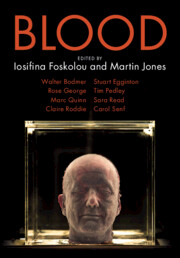Book contents
- Blood
- The Darwin College Lectures
- Blood
- Copyright page
- Contents
- Figures
- Notes on Contributors
- Acknowledgements
- Introduction
- 1 Battle Blood
- 2 Transitional Bleeding in Early Modern England
- 3 Blood in Motion, or the Physics of Blood Flow
- 4 Dracula, Blood, and the New Woman: Stoker’s Reflections on the Zeitgeist
- 5 Blood Lines of the British People
- 6 Heroes and Villains of Blood
- 7 Cold Blood: Some Ways by Which Animals Cope with Low Temperatures
- 8 Blood Sculptures
- Index
- References
5 - Blood Lines of the British People
Published online by Cambridge University Press: 13 June 2022
- Blood
- The Darwin College Lectures
- Blood
- Copyright page
- Contents
- Figures
- Notes on Contributors
- Acknowledgements
- Introduction
- 1 Battle Blood
- 2 Transitional Bleeding in Early Modern England
- 3 Blood in Motion, or the Physics of Blood Flow
- 4 Dracula, Blood, and the New Woman: Stoker’s Reflections on the Zeitgeist
- 5 Blood Lines of the British People
- 6 Heroes and Villains of Blood
- 7 Cold Blood: Some Ways by Which Animals Cope with Low Temperatures
- 8 Blood Sculptures
- Index
- References
Summary
The chapter opens with a concise history of the recognition of blood types that, as well as informing the human immune system, incidentally provide an ideal genetic data set for phylogenetic enquiry. The chapter goes on to relate that enquiry to the author’s People of the British Isles project. This project draws upon genetic data from just over 2,000 volunteers to construct a genetic map of the human population of the British Isles. From that genetic map, the peopling of the British Isles is inferred and reconstructed.
- Type
- Chapter
- Information
- Blood , pp. 84 - 117Publisher: Cambridge University PressPrint publication year: 2022

